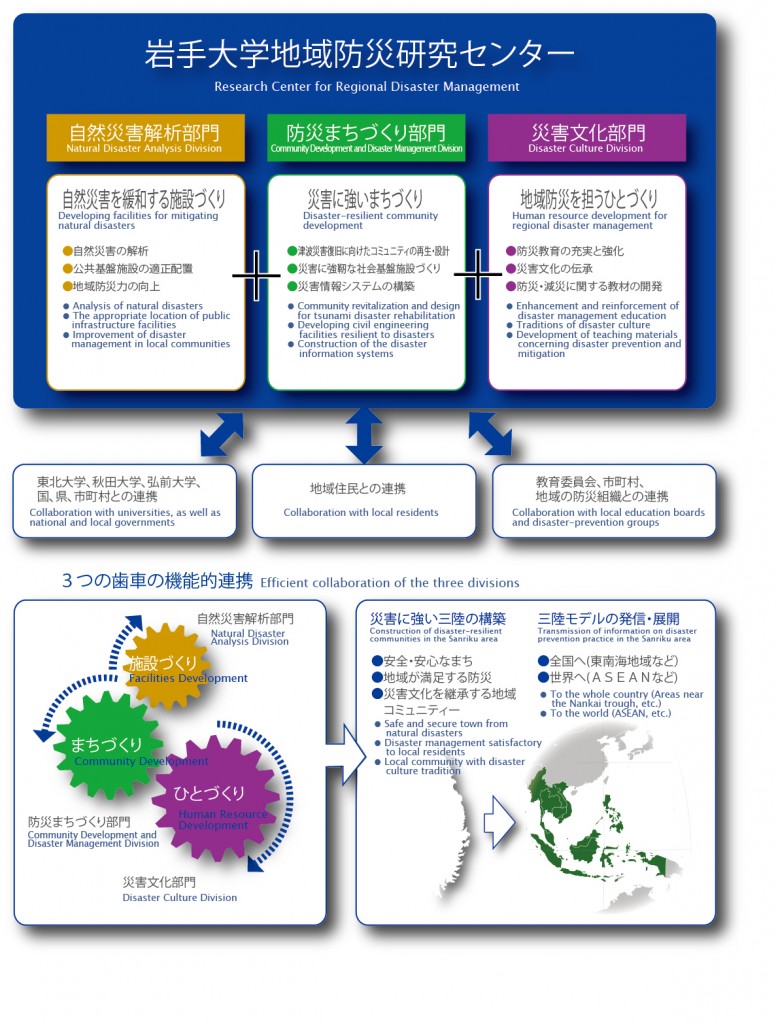地域防災研究センターの紹介 INTRODUCTION
地域防災力の向上に向けて
地域防災研究センターは、防災という観点から、地域をフィールドとし、地域社会を対象とし、または地域の人々との実践活動を通じて、自然科学的、工学的、政策論的または人文社会学的な問題を抽出し、それらを解決し、成果を地域社会に還元するのみならず、世界に発信していくことを目指しています。本センターで扱う防災には、災害の様々な側面、つまり、災害に遭ったときの災害応急対応、災害復旧・復興対応、災害予防・事前対応を含んでいます。また、対象とする自然災害も、地震や津波はもとより洪水や土砂災害などの風水害、火山災害に及びます。東日本大震災では、三陸沿岸地域が津波により壊滅的な被害を被り、復興もまだ途上にあり、本センターでは発災の直後から現在まで様々な局面で積極的に携わってきています。
本センターは、当初、工学部附属組織として立ち上がり、東日本大震災の翌2012年に岩手大学の全学組織として再構成され、現在に至っています。これを機に、自然災害解析部門、防災まちづくり部門および災害文化部門の3部門に構成に改め、それぞれ、自然災害のメカニズムの解明とハード対策、単なる復興復旧にとどまらず、災害に強く、活力あるまちづくり、および災害の様々なフェーズに対応できる人材づくりを目指しています。自然災害から得られる多くの教訓を生かして、よりよい地域社会の発展に寄与したいと考えています。
センター長 小笠原 敏記
Improvement of Resilience in Local Communities and Regional Societies against Natural Disasters
The Research Center for Regional Disaster Management, Iwate University, aims to identify and solve disaster-risk-reduction-related issues concerning natural science, engineering, public policy and /or social science, through investigations in local fields or communities and / or practical activities with people in local communities, and also aims to return resultant achievements to society as well as to transmit information about them to the world. The center deals with various phases of natural disaster including disaster prevention or preparedness, emergency response, and disaster recovery and reconstruction, and also study various kinds of natural disaster such as earthquake, tsunami, flood, slope collapse and volcanic eruption. In the case of the Great East Japan Earthquake in 2011, since which most of affected cities and towns in the Sanriku area have been still under recovery or reconstruction, many members of the center have been engaged in disaster risk reduction and / or reconstruction in the area.
The center, which was established in 2007 as an attached facility of the Engineering Faculty in the university, have been reorganized as a university-wide institution to have three divisions since 2012; they are natural disaster analysis, city planning and disaster management, and disaster culture divisions. Each division makes it a goal to clarify the mechanism of natural disasters and suggest useful structural measures, to make plans for resilient and vital cities or towns as well as suggestions for recovery and reconstruction of cities and towns, and to develop human resource for natural disaster risk reduction, respectively. We will contribute to make better society built on lessons learnt from natural disasters.
Director Toshinori Ogasawara
事業目的 Purpose
- 三陸沿岸での安全・安心な地域づくり
Safe and secure regional development in the Sanriku area - 災害文化の醸成・実践・継承
Creation, practice, and succession of disaster culture - 三陸モデルの発信
Information on disaster prevention practice in the Sanriku area
地域防災とは What is regional disaster management?
| 既存の防災研究機関では、地震津波の規模及び発生確率の想定に向けた研究が行われ、防発対策の基本方針の策定に大きく貢献してきました。 一方こうした「自然現象からみた防災」の観点での研究成果を踏まえ、地域ごとの具体的な防災計画を策定するためには「地域住民から見た防災」、つまり地域防災の観点が必要です。地域の地形、産業構造、歴史・文化などを考慮し、津波に災害に強い(1)施設づくり(2)まちづくりと、地域固有の災害文化を醸成・実践・継承する(3)ひとづくりを機能的に連携させたボトムアップ型防災システムが、ここで提案する地域防災です。 Existing disaster research institutes have studied scales and probability of earthquakes/tsunami, and contributed greatly to the development of fundamental policies for disaster preparedness. While such research outcomes toward disaster management by viewing disaster as a natural phenomenon provide the ground for drafting actual disaster management plans specific to each region, disaster management from the community s perspective or in other words the aspect of regional disaster management must form a core part of the disaster management plans. |
|
事業実施概要 outline
- これまで岩手大学が実施してきた地域密着型の活動(防災体制構築への支援、防災教育など)をさらに拡充し、東日本大震災による被災地の復興に向け、「施設づくり」「まちづくり」「ひとづくり」に貢献
The aim is to expand practical disaster management activities of local communities which have been implemented by the faculty members of Iwate University. These activities concern support for the construction of disaster management systems, the education of disaster prevention and mitigation, and contribution to the development of facilities, communities and human resources for recovery and reconstruction in the devastated areas struck by the Great East Japan Earthquake and Tsunami in 2011. - 地域特性に応じた防災対策と、津波常襲地帯に暮らすための知恵である災害文化からなるボトムアップ型防災システム(三陸モデル)を構築
Constructing community-based and bottom-up disaster management system for residents living in areas frequently struck by tsunami, based on their traditional disaster culture. - 三陸モデルを、今後巨大地震の発生が危惧される東南海地域などへ展開
Transmitting information on disaster prevention practices accumulated in the Sanriku area to communities which will be possibly struck by huge earthquakes in the near future. - 岩手県が構想する「国際的防災研究拠点(案)」の中核機能として実施
Functioning as “the International Center for Disaster Prevention Research” planned by the Iwate Prefectural Government. - 他大学、他研究機関と連携し、相互補完的な事業実施により効果的な成果を創出
And creating fruitful results by collaborating with other universities and research groups.



